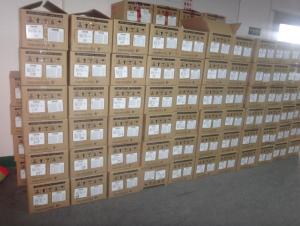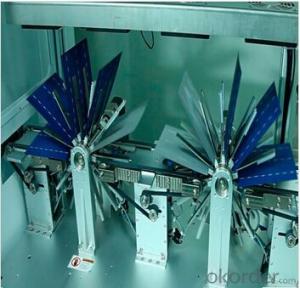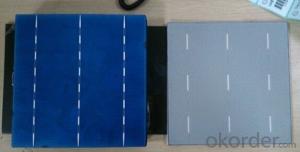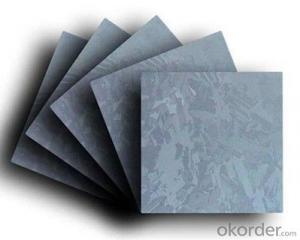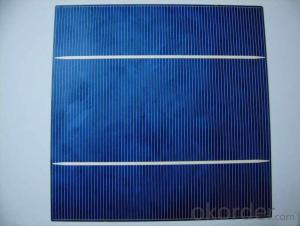Mono Solar Cells156mm*156mm in Bulk Quantity Low Price Stock 19.8
- Loading Port:
- Shanghai
- Payment Terms:
- TT OR LC
- Min Order Qty:
- 1000 pc
- Supply Capability:
- 100000 pc/month
OKorder Service Pledge
OKorder Financial Service
You Might Also Like
Brief Introduction
- Up to 20.0% efficiency, one of the highest performing mono crystalline cells on the market
- Three bus bars boosts current collection over the entire cell area, leading to higher fill factors
- Blue anti-reflecting coating allows more sunlight be captured and converted to electricity
- Finer, closer fingers improves charge collections for improved energy yield
- Lower light-induced degradation leads to greater power output over the entire module lifetime
- All solar cells are tightly classified to optimize output of module
- Maximum yield and longevity due to hotspot prevention
- Premium appearance results in a highly uniform and aesthetically appealing module
Specification
- Product Mono-crystalline silicon solar cell
- Dimension 156 mm x 156 mm ± 0.5 mm
- Thickness 200 μm ± 30 μm
- Front 1.5 ± 0.1 mm busbar (silver)
- Silicon nitride antireflection coating
- Back 3.0 mm continuous soldering pads (silver)
- Back surface field (aluminum)
Electric performance parameters

- Testing conditions: 1000 W/m2, AM 1.5, 25 °C, Tolerance: Efficiency ± 0.2% abs., Pmpp ±1.5% rel.
- Imin : at 0.5 V
Light Intensity Dependence
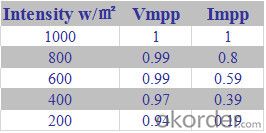
Soldering Ability
- Peel Strength: > 1.0 N/mm (Pull soldered ribbon from busbar in 5 mm/s of 180°)
Dimension Figure

Quick Response
- Any time and anywhere, reply clients' email and solve all problems happen in the work at the first time.
- Remove clients doubts and offer the best solution at the first time.
- Give our clients the lastest news of the photovoltaic, update the newest stock informtion.
Production and Quality Control
- Precision cell efficiency sorting procedures
- Stringent criteria for color uniformity and appearance
- Reverse current and shunt resistance screening
- ISO9001,ISO14001 and OHSAS 18001,TUV Certificated


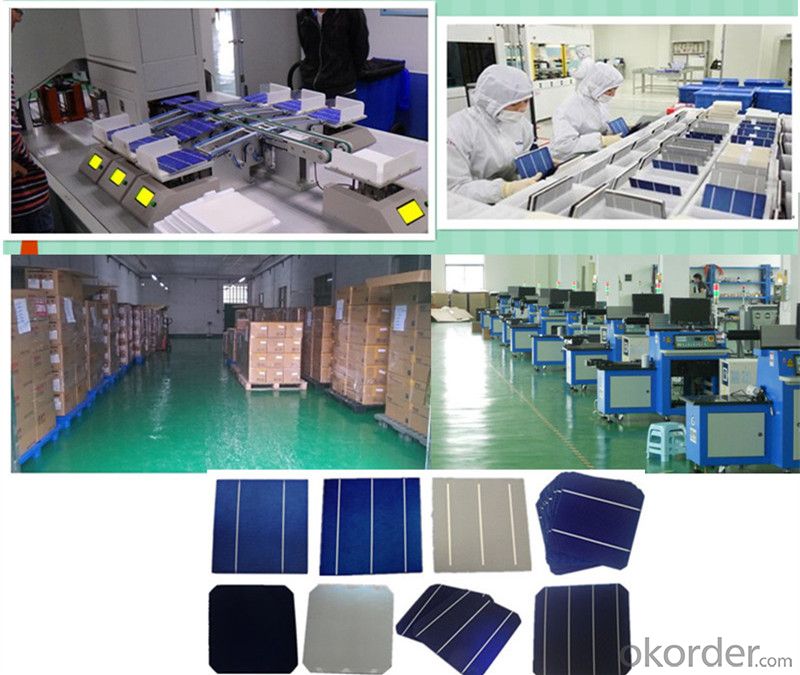
FAQ:
1. Q: Do you have your own factory?
A: Yes, we have. Our factory located in Jiangsu
2. Q: How can I visit your factory?
A: Before you visit,please contact us.We will show you the route or arrange a car to pick you up.
3. Q: Do you provide free sample?
A: Commenly we provide paid sample.
4. Q: Could you print our company LOGO on the nameplate and package?
A: Yes, we accept it.And need an Authorization Letter from you.
5. Q: Do you accept custom design on size?
A: Yes, if the size is reasonable.
6. Q: How can I be your agent in my country?
A: Please leave feedback. It's better for us to talk about details by email.
7. Q: Do you have solar project engineer who can guide me to install system?
A: Yes, we have a professional engineer team. They can teach you how to install a solar system.
- Q:How do solar silicon wafers perform in areas with high air pollution?
- Solar silicon wafers tend to perform less efficiently in areas with high air pollution. The presence of pollutants in the air, such as dust, smog, and particulate matter, can accumulate on the surface of the solar panels, blocking sunlight and reducing their overall energy production. Additionally, the deposition of pollutants can cause corrosion and damage to the panels over time, further decreasing their performance. Regular cleaning and maintenance can help mitigate the impact of air pollution on solar silicon wafers in such areas.
- Q:4 inch polished silicon wafer thickness of 250um, after polishing the thickness of 6 inches of 300um, the current use of wax free polishing process often fragments, to find a solution!
- I don't know how your employees operateYou can put a small bubble in the insertion box below if it is convenient. Can play a buffer role
- Q:How are solar silicon wafers protected from electrical surges?
- Solar silicon wafers are protected from electrical surges through the use of protective devices such as surge suppressors and transient voltage suppressors. These devices are installed in the solar power system to divert excess voltage and current away from the wafers, preventing damage to the delicate electronic components.
- Q:Solar silicon wafer cutting fluid content is polyethylene glycol, flash point 182-278 DEG C, saturated vapor pressure of 6.21KPa/20 C / C in storage in the barrel, after exposure, its volatile gas is harmful?
- Combustible gas is hydrogen is not polyethylene glycol, but no matter because of ventilation, ventilation, to avoid the closed environment in the case of an open flame on the line
- Q:Can solar silicon wafers be used in floating solar power plants?
- Yes, solar silicon wafers can be used in floating solar power plants. These floating solar power plants are designed to harness solar energy by placing photovoltaic panels on floating platforms on water bodies such as lakes, reservoirs, or even the ocean. The solar silicon wafers serve as the main component of the photovoltaic panels, converting sunlight into electricity. Floating solar power plants offer numerous advantages, including increased efficiency due to the cooling effect of the water and the ability to utilize unused water surfaces, making solar silicon wafers a suitable choice for such installations.
- Q:What is the role of light trapping in solar silicon wafers?
- The role of light trapping in solar silicon wafers is to enhance the absorption of sunlight by increasing the path length of light within the wafer. This allows for a greater amount of light to be absorbed, resulting in improved efficiency of the solar cell.
- Q:Are there any regulations or standards for solar silicon wafers?
- Yes, there are regulations and standards for solar silicon wafers. These standards are established by various organizations such as the International Electrotechnical Commission (IEC) and the American Society for Testing and Materials (ASTM). These standards ensure the quality, efficiency, and reliability of solar silicon wafers, covering factors such as dimensions, electrical properties, and material purity. Compliance with these regulations and standards is crucial for the solar industry to maintain consistency and facilitate widespread adoption of solar technology.
- Q:How long does it take to produce a solar silicon wafer?
- The production time for a solar silicon wafer can vary depending on various factors, such as the manufacturing process and the desired quality and specifications. However, on average, it takes around 2 to 4 weeks to produce a solar silicon wafer from start to finish.
- Q:How is an encapsulant applied to a solar silicon wafer?
- An encapsulant is typically applied to a solar silicon wafer by using a process called lamination. In this process, a layer of encapsulant material, usually ethylene-vinyl acetate (EVA), is placed between the silicon wafer and a top layer of glass. The wafer, encapsulant, and glass are then sandwiched together and subjected to heat and pressure. This causes the encapsulant to melt and flow, adhering to the wafer and creating a protective layer that encapsulates the solar cells.
- Q:Can solar silicon wafers be used in telecommunications infrastructure?
- Yes, solar silicon wafers can be used in telecommunications infrastructure. They are commonly used in the manufacturing of solar cells, which can be integrated into telecom equipment to power various components such as base stations, repeaters, and remote communication systems. By harnessing solar energy, these wafers contribute to sustainable and off-grid telecom solutions in remote areas or during power outages.
1. Manufacturer Overview |
|
|---|---|
| Location | |
| Year Established | |
| Annual Output Value | |
| Main Markets | |
| Company Certifications | |
2. Manufacturer Certificates |
|
|---|---|
| a) Certification Name | |
| Range | |
| Reference | |
| Validity Period | |
3. Manufacturer Capability |
|
|---|---|
| a)Trade Capacity | |
| Nearest Port | |
| Export Percentage | |
| No.of Employees in Trade Department | |
| Language Spoken: | |
| b)Factory Information | |
| Factory Size: | |
| No. of Production Lines | |
| Contract Manufacturing | |
| Product Price Range | |
Send your message to us
Mono Solar Cells156mm*156mm in Bulk Quantity Low Price Stock 19.8
- Loading Port:
- Shanghai
- Payment Terms:
- TT OR LC
- Min Order Qty:
- 1000 pc
- Supply Capability:
- 100000 pc/month
OKorder Service Pledge
OKorder Financial Service
Similar products
New products
Hot products
Hot Searches
Related keywords
